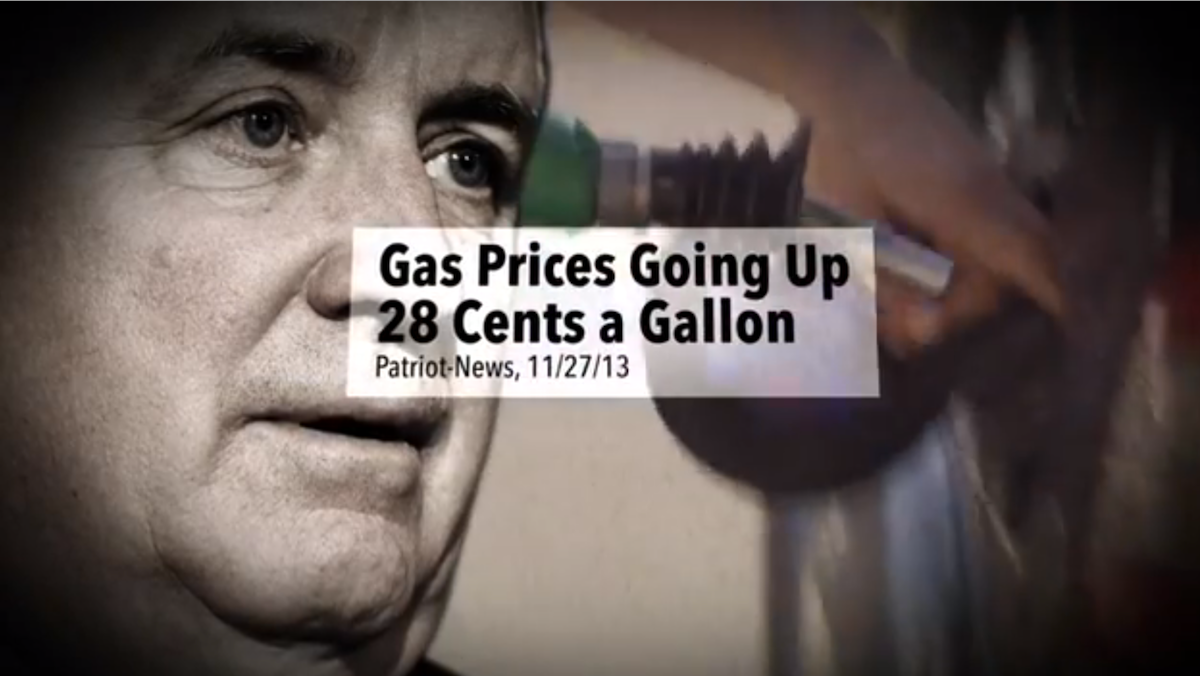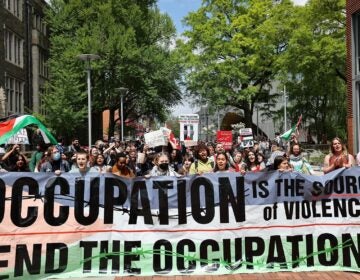Q&A: ‘Philly Political Media Watch’ highlights gap between campaign ads, coverage

Screen grab from Tom Wolf's 'Fact Check' commercial in his 2014 campaign against then-Gov. Tom Corbett. (Image via Wolf For Governor YouTube page)
Are you learning more about political candidates from television-news stories or the biased campaign ads that you don’t skip courtesy of your DVR’s fast-forward button?
While candidates running for mayor of Philadelphia haven’t gone up with TV ads in any big way — yet — researchers sought to answer that question during the 2014 election season through the “Philly Political Media Watch” project.
Helmed by Danilo Yanich of the University of Delaware’s Center for Community Research & Service School of Public Policy & Administration — and backed by groups including the Committee of Seventy — the project aimed to “shed light on the media landscape of a major city as money is pumped into political advertising.”
The findings were stark. From the study’s executive summary:
In the final eight weeks before Election Day 2014, six broadcast television stations that serve the Philadelphia metro area benefited from a $14.4 million bonanza in political ads. Over that same period those stations aired fewer than 19 minutes of substantive political stories – those devoted to actual campaign issues as opposed to news of candidate appearances.” …
Political news stories, meanwhile, got far less airtime: an examination of news programming from Sept. 8 through Election Day showed that Philadelphia-area viewers were exposed to four times as much political advertising as political journalism during news broadcasts.
The disparity grew even wider when researchers separated stories that dealt with substantive campaign issues from those that related basic information such as candidate schedules or polling place information.
The ratio of news hour time devoted to paid political advertising compared to that devoted to political issue stories: 45 to 1.
You can see the study’s 57-page report via this (PDF).
Last week, NinetyNine spoke with Yanich and Committee of Seventy President and CEO David B. Thornburgh about what the report means.
Here’s what they had to say:
NinetyNine: One thing that jumped out at me about the report was a call to, as a result, rethink the role of local news in today’s political campaigns. Please expand on that.
David Thornburgh (DT): What strikes me about local news is the explosion of options and the flattening of the way news is covered. We have a lot more outlets, points of view, perspectives; there are many more little streams that feed the big stream.
What we’re recognizing in this study is that maybe the dominant sources of news are disappearing in substance. If we look at that from a glass-is-half-full perspective, hopefully that slack is being taken up by the proliferation of options.
We’re in the midst of a huge upheaval of how news is covered.
Danilo Yanich (DY): At the very least, what [TV news programs] would do is look into every claim in the ads, by whatever approach [they choose]. For example, there were 8,003 ads [we looked at], but only 71 unique ads, and they were broadcast many times.
It seems to me that an enterprising [TV] reporter could take a look, even if it’s a small sample, because you’ve put them on your air 8,000 times. Take a look at the claims on these ads and make some judgment about the accuracy. Political advertisers shade their message one way or another, and local news can’t reject [a commercial] from candidate, only from [a PAC]. Sell those ads at the lowest rate. Then, [a story where the station says] ‘Ok, we presented these claims, but to what extent are they accurate?’ at the very least.
99: How will this play out in a mayoral race that has limited TV-spending potential?
DT: This is the interesting thing: For a variety of reason, the candidates have not raised enough money to go up on TV in a big way, and I’m not convinced that is the end of democracy as we know it. We should figure out, when smoke clears, if people feel less informed. TV is for blunt images; it doesn’t transmit substantive issues.
DY: If this is any guide … all it would take is for some benefactor who wants to establish Republican credibility for a challenger, someone who decided make this a race, [could say] ‘even if we don’t win, we may win next time.’
The structure is in place given how ads and lack of coverage affect political communication given what happened in Philadelphia. [Gubernatorial candidate Tom] Wolf was up on air early because he could. So, he was smart with how he did the ad buys.
I would not at all be surprised if something happened in the general election only because it doesn’t take much. All it takes is one benefactor to say “I’m going to support so-and-so, and flood the airwaves.'”That’s what political communication is now. It’s not journalism; it’s ads.
I have empathy for many of the folks in [broadcast TV] organizations who’d like to practice quality journalism but the organizational imperative is to move them away from that. There are reporters and journalists who, if they somehow had autonomy, would do this political story rather a story about whether Britney Spears is feeling well or not. But no, they have to do the Britney one because they have to 2.4 stories a day.
[Saying they’re doing the stories that viewers want to see is akin to] blaming the victim. No, that’s what you’ve given them. No wonder why people are cynical.
99: Do expanded online-news offerings help mitigate this? Maybe people are turning there instead of TV for political stories.
DY: No question that will help, but it doesn’t replace journalism. If the thought is ‘we’ll be light and they can go somewhere else to get it,’ well, give me your license then.
Individuals do not have first-hand knowledge about what’s going on. They say they get their news from Facebook. No, you don’t. You got it from someone who got a link for you.
It ain’t the dot com that matters; it’s what in front of it. … The business model is broken down, and we’re tying to find another one. Because of all the consolidation at local stations, that’s why I’m doing this, to achieve economies of scale. There’s been a net gain in news? That suggestion is absurd, but the FCC bought that [in considering consolidation].
99: What, if anything, is being done with this information/process for the 2015 local elections?
DT: I think we’re solidly in line that data like this has to be as accessible as humanly possible. [Political messages can be] manipulated and translated easily. I wouldn’t let TV folks off the hook because they have a responsibility, legally and civically, to help folks understand what’s going on out there.
The ratio of ads to substance [leads to] questions. Is it because TV ads have increased so much, or because news coverage has decreased? I think it’s more that TV advertising has increased.
There’s a classic book written about the mayor’s race in the early 90s, “The Media and the Mayor’s Race: The Failure of Urban Political Reporting,” and even then, TV was not a great font of knowledge and political information.
DY: We would have liked to have done it, to look at the ads now. [Our approach to the study] is unprecedented stuff; no one else has done it this way before. But, the timing is pretty tough for us. If I could find some funding really quick, I would do it. Even if it was just a small sample, a monthly sample.
It’ll be very interesting if someone wants to come into the race, someone who has enough money [to do heavy advertising]. If someone said, even to [Republican candidate Melissa Murray] Bailey, “It’s not that you’re going to win, but here’s more money to position Philadelphia as a place where we could spend more for the 2016 elections.”
This is not one election at a time. This is a process.
99: Help us find something positive to take away from this study.
DT: The positive is the glass half-full story: That there are lots of other places to get information now.
As I jumped into this job [several months ago], I was struck in positive way about how many organizations, groups, bloggers have been in this [field of coverage]. If want to find information in Philadelphia, you can.
DY: Well, the Columbia Journalism Review framed it as “everything we thought was wrong with the process but were afraid to know.”
What I see in terms of being positive is that it’s documented, and was done with scientific rigor. What I tell students all the time is that everything you do must be bulletproof. If you’re going into policy arena; it’s not neutral.
I know what we did in terms of scientific rigor. The point to it: This is what happened; we know it for a fact. That’s important. In the past, it was anecdotal. People in news organizations making the case for better coverage will have this to point to now.
We gotta do better. I don’t see [TV] news organizations as being monolithic. People there are empathetic; they say “maybe if we practice some more journalism, it’ll be good for the bottom line. If we keep it up with the Kardashians, Spears stories, sooner or later, they’ll simply turn us off.”
People do look [to television] for political news. If the ads cancel that out, then we’re all being punished.
WHYY is your source for fact-based, in-depth journalism and information. As a nonprofit organization, we rely on financial support from readers like you. Please give today.




